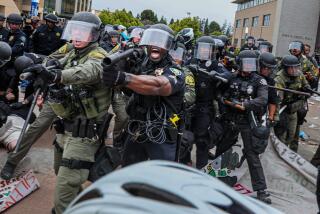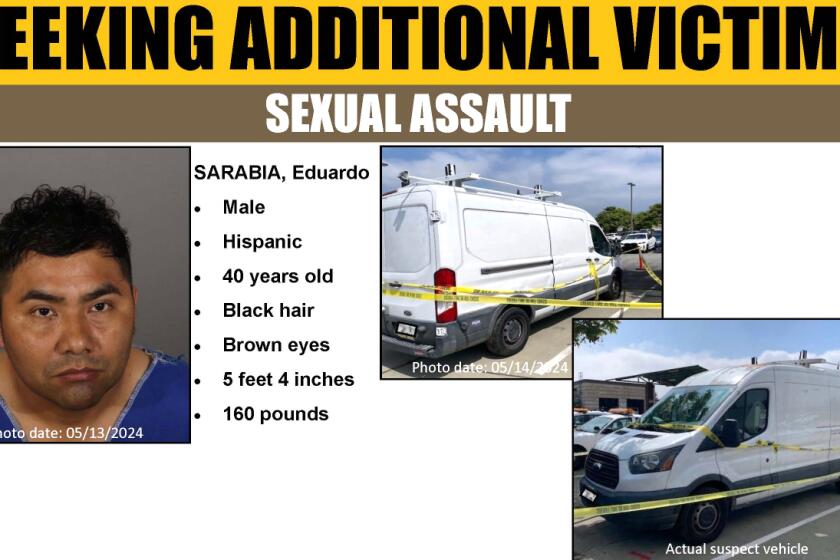New Evidence Frees O.C. Robbery Convict
A man who spent 1 1/2 years in jail for a Santa Ana street robbery was released Friday night after a judge set aside his conviction in light of new evidence that someone else committed the crime.
Judge Richard F. Toohey granted Richard Eddie Perez a new trial after defense attorneys presented evidence that linked the robbery to a man who is awaiting trial in a string of highly publicized rapes and robberies last year.
A jury convicted Perez, 19, in January based largely on the testimony of one witness--and what his defense attorneys described as a chain of unfortunate coincidences.
Prosecutors said they are going reopen the investigation into the robbery and determine whether to retry Perez or file charges against someone else.
Perez was released shortly after 10 p.m. from the Theo Lacy Branch Jail in Orange. His family had made arrangements for a limousine to pick him up, but he was released before it arrived. As he waited, dressed in a white paper jumpsuit and plastic sandals, he said: “I was shocked when they told me the charges. I wasn’t guilty of this, and it took 19 months for them to figure it out. Right now I just want to go home to my family.”
Earlier, Perez’s father, Juan, said: “It’s been hard. It’s been stressful. I feel relieved--but not completely because it’s not over.”
The case began in March 2000 when a woman spotted Perez walking on a Santa Ana street and told police he was the man who robbed her at knifepoint in an apartment carport, making off with some distinctive Mexican jewelry.
Shortly before the trial, Perez’s mother, Martha, read a newspaper story about Eduardo Guzman, the suspect in a series of Santa Ana rapes and robberies in the same neighborhood.
She noticed that Guzman and her son had similar light complexions and closely trimmed mustaches. Moreover, she noticed that Guzman was accused of crimes highly similar to the one that her son was charged with committing.
But during the trial, Judge Toohey would not allow the defense to accuse another suspect without something more than a mother’s instincts. In January, after one day of deliberation, a jury convicted Perez of the robbery. He faced up to 10 years in prison.
After the verdict, Martha Perez hired a new lawyer, Edward Munoz, who learned from police reports that Guzman allegedly gave stolen jewelry to friends. A defense investigator visited Guzman’s former girlfriend and told her about Perez’s plight. She dug up a silver Aztec calendar medallion identical to the one stolen in the Perez case. She said Guzman gave it to her sister, who then gave it to her.
Faced with the new evidence, Deputy Dist. Atty. Anne Tremblay on Friday agreed that Perez’s robbery conviction should not stand.
“We got lucky,” Munoz said. “He’s going to be spared from going to prison for something he didn’t do.”
The Perez case marked the fourth time in less than two years that Orange County prosecutors have agreed to drop convictions amid allegations of mistaken witness testimony. It comes one month after a judge ordered the release of a fifth man, George Lopez, amid mounting evidence that he too was wrongly convicted of an Orange County robbery.
The woman who implicated Perez selected his photograph from a series of booking mugs and later identified him in court. At Perez’s house, police found a New York Yankees baseball cap and dark Windbreaker similar to the clothing worn by the robber.
“She was a good witness, and I believed her to be telling the truth,” Tremblay said.
Still, some legal experts said the case highlights how unreliable witness identifications can be.
“When it’s a pure eyewitness identification case, I think there’s a yellow flag that has to go up,” said Brent Romney, a former Orange County prosecutor and professor at Western State University College of Law. “Now, with all these cases coming forth, prosecutors across the state and the country have to look more closely at these cases.”
Martha Perez said she’s not angry about her son’s plight but hopes it can serve as a lesson.
“I want the community to know, these things happen. Be very careful when you identify someone,” she said. “And if you’re a juror, ask questions. Where’s the fingerprints? Where’s the other evidence? They didn’t do that.”
More to Read
Start your day right
Sign up for Essential California for news, features and recommendations from the L.A. Times and beyond in your inbox six days a week.
You may occasionally receive promotional content from the Los Angeles Times.







